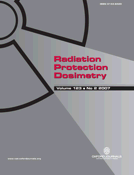-
Views
-
Cite
Cite
Hiroki Fujita, Tetsuo Hashimoto, Usability of VTL from natural quartz grains for retrospective dosimetry, Radiation Protection Dosimetry, Volume 123, Issue 2, February 2007, Pages 143–147, https://doi.org/10.1093/rpd/ncl108
Close - Share Icon Share
Abstract
To develop retrospective dosimetry of unexpected radiation accident, basic studies on violet thermoluminescence (VTL) phenomena were conducted using natural quartz grains. All VTL glowcurves of as-received samples did not exhibit peaks <250°C, although for artificially irradiated quartz samples there were VTL peaks in the temperature region <250°C. Therefore, accident doses could be estimated without the interference of naturally accumulated doses by VTL measurements from natural quartz. The mean lives of VTL were evaluated by the various heating rates method and the range of values was found to be between some days and ten thousands of years depending on each peak. Especially, the mean life of VTL peak at 200°C was years order. Furthermore, the lower detection limit was calculated to be tens of mGy from the response curve. This value was lower than that of other methods such as ESR dosimetry. From these results, we conclude that VTL dosimetry can be preferred for accidental evaluation.



